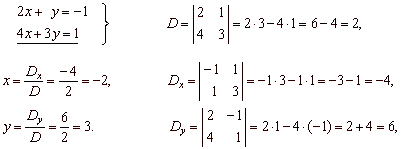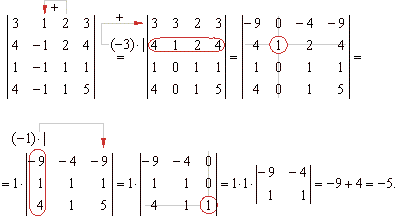|
|
|
|
ALGEBRA
|
|
|
|
Systems
of linear equations
|
|
::
Cramer’s
rule, using the determinant to solve systems of linear equations
|
|
Solving system
of two equations in two unknowns
using
Cramer's rule
|
|
A system of two equations in two unknowns, the solution to a system
by Cramer’s rule (use of determinants).
|
 |
|
the solution to the system |
 |
|
|
|
|
| Example:
Solve given system of
linear equations using Cramer’s rule.
|
 |
|
|
|
|
Method of expanding a
determinant of a rank n
by cofactors, example
|
|
Property
of a determinant: The value of a determinant will not change by adding multiples of
any column or row to any other column or row. This way created are zero entries that simplify subsequent calculations.
|
|
Example:
An application of the method of expanding a determinant to
cofactors to evaluate the determinant of the rank four. |
 |
|
Added is third to the second colon. Then, the second row multiplied
by -3 is added to the first row. The obtained determinant is then
expanded to its cofactors along the second colon:
|
 |
|
The first colon multiplied by
-1 is added to the third colon. The
obtained determinant is then expanded along the third colon.
|
|
|
|
|
Absolute value equations
|
|
::
Solving absolute value
equations
|
|
To
solve an absolute value equation, isolate the absolute value on
one side of the equation, and use the definition of absolute
value.
|
|
The absolute value of a real number a,
denoted |
a |,
is the number without its
sign and represents the distance between 0 (the origin) and that
number on the real number line.
|
|
Thus, regardless of the value of a number
a
its absolute value is
always either positive or zero, never negative that is, | a
|
> 0.
|
|
|
| Example:
|
1
- 2x
| = 17
|
|
Solution:
1
-
2x =
17
or
1 -
2
x = -
17
|
|
2
x = - 16
2x =
18
|
|
x = -
8
x = 9
|
| The
solutions to the given equation are
x = - 8
and
x = 9.
|
|
| Example:
|
x + 2 | =
| 2x -
5 |
|
|
Solution: As both
sides of the equation contain absolute values the
only way the two sides are equal is, the two quantities
inside the absolute value bars are equal or equal but with
opposite signs.
|
|
x + 2 = 2x
-
5
or
x + 2 = -
(2
x -
5)
|
|
x -
2x
= -
5 -
2
x + 2 = -
2
x +
5
|
|
-x =
-
7
3x = 3
|
|
x = 7
x = 1
|
| Check
solutions: x =
7 =>
|
x + 2 | =
| 2x -
5 |, x = 1
=>
|
x + 2 | =
| 2x -
5 |
|
|
|
7 + 2 | =
| 2 · 7 -
5
|
|
1 + 2 | = | 2 ·
1 -
5 |
|
|
9 = 9
3 = | -3 |
|
| Therefore,
the
solutions to the given equation are x =
7 and x =
1.
|
|
|
|
|
Inequalities
|
|
::
Linear
inequality
|
|
Solving
inequalities: The solutions to an inequality are all values of
x
that make the inequality true. Usually the answer is a range of
values of x
that we plot on a number line.
|
|
Multiplying or dividing both sides of an inequality
by the same negative number, the sense of the inequality changes,
i.e., it reverses the direction of the inequality sign.
|
|
|
Example: 3(x -
2) >
-
2(1-
x)
|
|
Solution:
3x -
6
>
-2
+
2x |
 |
|
x > 4 |
the
interval
notation
(4, oo) |
|
|
The
open interval (4,
oo) contains all real numbers between given endpoints, where round
parentheses indicate exclusion of endpoints.
|
|
|
|
|
|
::
Compound or
double inequalities
|
|
Use the same procedure to solve a compound inequality as for solving single inequalities.
|
|
|
|
|
|
|
|
|
|
|
|
|
|
|
|
|
|
|
|
|
|
|
|
|
|
|
|
|
|
Contents A
|
|
|
|
|

|
|
|
|
|
|
Copyright
© 2004 - 2020, Nabla Ltd. All rights reserved.
|
|
|